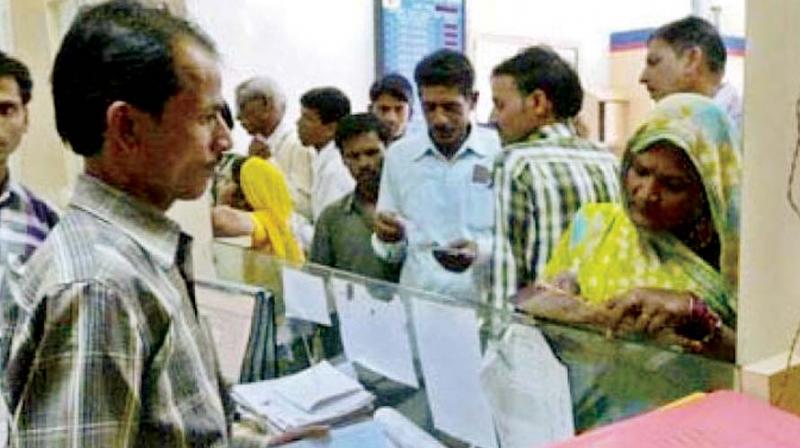The price of social banking
All these highlighted how unenlightened politician can play havoc with financial systems.

It is true that banks can play an important role in the financial transformation of low-income communities, but sustainability should never be overlooked. In their excitement to oblige their constituencies, politicians run financially amok and literally plunder banks for their vote blocks. This was precisely the reason why India’s post nationalisation mass banking programmes degenerated into populist agendas which financially ruined the banks. All these highlighted how unenlightened politician can play havoc with financial systems. The entire execution lacked the soul of a genuine economic revolution because it was not conceived by the grassroots agents but assembled by starry-eyed mandarins who had picked up bits and pieces about financial inclusion from pompous new fangled and half baked ideas generated at seminars and conferences.
The original banking concept, based on security oriented lending, was broadened to a social banking concept based on purpose oriented credit for development. This called for a shift from urban to rural oriented lending. Social banking was conceptualised as “better the village, better the nation”. However, opening new branches in rural areas without proper expansion, planning and supervision of end use of credit or creation of basic infrastructure facilities meant that branches remained mere flag posts. It was a make believe revolution that was to lead to a serious financial crisis in the years to come.
The initial impetus for social banking in India came from the report of the 1951 All-India Rural Credit Survey which concluded that lack of access to commercial banks was a root cause of rural poverty (Reserve Bank of India,1954). This resulted in the setting up of State Bank of India for initiating social banking in India. In 1969, the fourteen largest Indian commercial banks were nationalised, at which point they came under the direct control of the Indian Central bank and were formally incorporated into the planning architecture of the country. The point of bank nationalisation was to empower the state to target financial backwardness as a means of promoting social objectives. A central aim was to reduce and equalise the average population per bank branch across Indian states.
The object of social banking was to bring home two facts and four effects.
The two facts were:
1. That right from the time of Independence, the over riding concern of development policy makers has been to find ways and means to finance the poor and reduce the burden upon them.
2. Between the concern of the policy makers and the quality of the effort, however, there was a gap. The efforts made were not able to achieve the success envisaged for a variety of reasons mainly because of the defects in policy design, infirmities in implementation and the inability of the government of the day to desist from resorting to measures such as loan waivers.
The four consequences flowing from these facts are:
1. That the banking system was not able to internalise lending to the poor as a viable activity but only as a social obligation. It was something that had to be done because the authorities wanted it so. This was translated into the banking language of the day:
2. Loans to the poor were part of social sector lending and not commercial lending;
3. The poor were not borrowers, they were beneficiaries;
4. Poor beneficiaries did not avail of loans they availed of assistance.
The politicians believe banks can bring economic revolution through rural credit, which is just like expecting a midwife to deliver a baby. In a developing country, it is not enough just to provide credit for production. Production itself must be increased with the adopting of improved technology.
The Integrated Rural Development Programme (IRDP) is a grim reminder of how mechanically trying to meet targets can undermine the integrity of a social revolution to such an extent that a counter revolution can be set into motion. Arguably India’s worst ever development programme, the IRDP intended providing income generating assets to the rural poor through the provision of cheap bank credit. Little support was provided for skill formation, access to inputs, markets and necessary infrastructure. In the case of cattle loans, for example, a majority of cattle owners reported that either they had sold off the animals bought with the loan or that these animals were dead. Cattle loans were financed without adequate attention to other details involved in cattle care: fodder availability, veterinary infrastructure, marketing linkages for milk, etc.
Working for the poor does not mean indiscriminately thrusting money down their throats. Unfortunately, IRDP did precisely that. The programme did not attempt to ascertain whether the loan provided would lead to the creation of a viable long-term asset nor attempt to create the necessary forward and backward linkages to supply raw material or establish marketing linkages for the produce. Little information was collected on the intended beneficiary. The IRDP was principally an instrument for powerful local bosses to opportunistically distribute political largesse. The abiding legacy of the programme for India’s poor has been that millions have become bank defaulters through no fault of their own. Today, the people so marked find it impossible to rejoin the formal credit stream.
The IRDP alone accounted for 40 per cent of the losses incurred by commercial banks in rural lending in India. By the end of the 1980s, great concern began to be expressed about the low capital base, low profitability, and high percentage of non-performing assets of public sector banks, whose earnings were invariably lower than their loan losses and transaction costs. They required continual refinancing and recapitalisation by apex institutions. The final nail in the coffin was the official loan waiver of 1989, which destroyed whatever semblance of credit discipline remained.
There are two basic prerequisites of a poverty eradication programmes. Firstly, reorientation of the agricultural relations so that the ownership of land is shared by a larger section of the people. Secondly, programmes for alleviating poverty cannot succeed in an economy plagued by corruption, inflation and inefficient bureaucracy.
The writer is a well-known banker, author and Islamic researcher. He can be reached at moinqazi123@gmail.com

